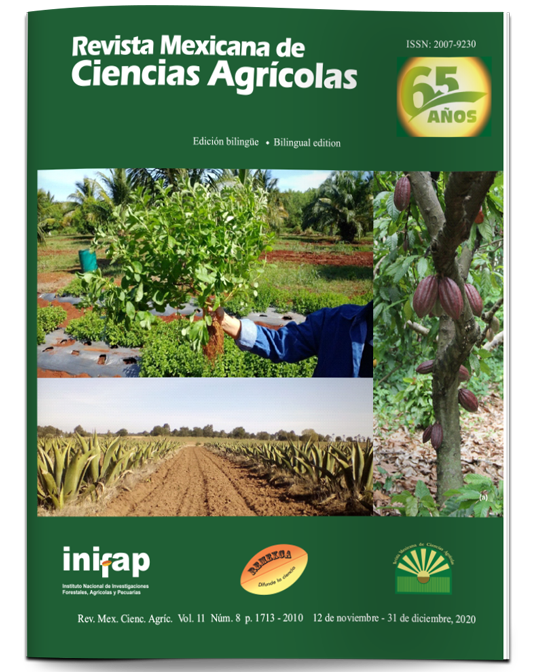Seed yield and fruit quality of habanero pepper with chemical and organic fertilization
DOI:
https://doi.org/10.29312/remexca.v11i8.1960Keywords:
Capsicum chinense Jacq., germination, organic productionAbstract
The objective of the present investigation consisted in evaluating populations of habanero pepper, with chemical and organic fertilization, for seed and fruit yield. In 2017, at the National Technology of Mexico campus Roque, three genotypes of habanero pepper were established with five different types of fertilization. A group of agronomic variables were evaluated with the SNICS norms. The variables were subjected to an analysis of variance and principal components. The best collection was the Rojo Campeche 12 genotype with an average fruit weight of 4.8 g, 27.5 seeds per fruit and a germination at 16 days of 39.2%. Regarding fertilization, it was determined that the best fruit weight was reached with 50+50% of chemical and organic fertilization. For seeds per fruit and germination, chemical fertilization was better, although statistically similar to the value of combined fertilization (50+50). The above allows to explore genotypes, doses and application opportunities of organic fertilizers that improve seed production and quality, with sustainable and environmentally friendly management.
Downloads
Published
How to Cite
Issue
Section
License
Copyright (c) 2020 Revista Mexicana de Ciencias Agrícolas

This work is licensed under a Creative Commons Attribution-NonCommercial 4.0 International License.
The authors who publish in Revista Mexicana de Ciencias Agrícolas accept the following conditions:
In accordance with copyright laws, Revista Mexicana de Ciencias Agrícolas recognizes and respects the authors’ moral right and ownership of property rights which will be transferred to the journal for dissemination in open access. Invariably, all the authors have to sign a letter of transfer of property rights and of originality of the article to Instituto Nacional de Investigaciones Forestales, Agrícolas y Pecuarias (INIFAP) [National Institute of Forestry, Agricultural and Livestock Research]. The author(s) must pay a fee for the reception of articles before proceeding to editorial review.
All the texts published by Revista Mexicana de Ciencias Agrícolas —with no exception— are distributed under a Creative Commons License Attribution-NonCommercial 4.0 International (CC BY-NC 4.0), which allows third parties to use the publication as long as the work’s authorship and its first publication in this journal are mentioned.
The author(s) can enter into independent and additional contractual agreements for the nonexclusive distribution of the version of the article published in Revista Mexicana de Ciencias Agrícolas (for example include it into an institutional repository or publish it in a book) as long as it is clearly and explicitly indicated that the work was published for the first time in Revista Mexicana de Ciencias Agrícolas.
For all the above, the authors shall send the Letter-transfer of Property Rights for the first publication duly filled in and signed by the author(s). This form must be sent as a PDF file to: revista_atm@yahoo.com.mx; cienciasagricola@inifap.gob.mx; remexca2017@gmail.
This work is licensed under a Creative Commons Attribution-Noncommercial 4.0 International license.



